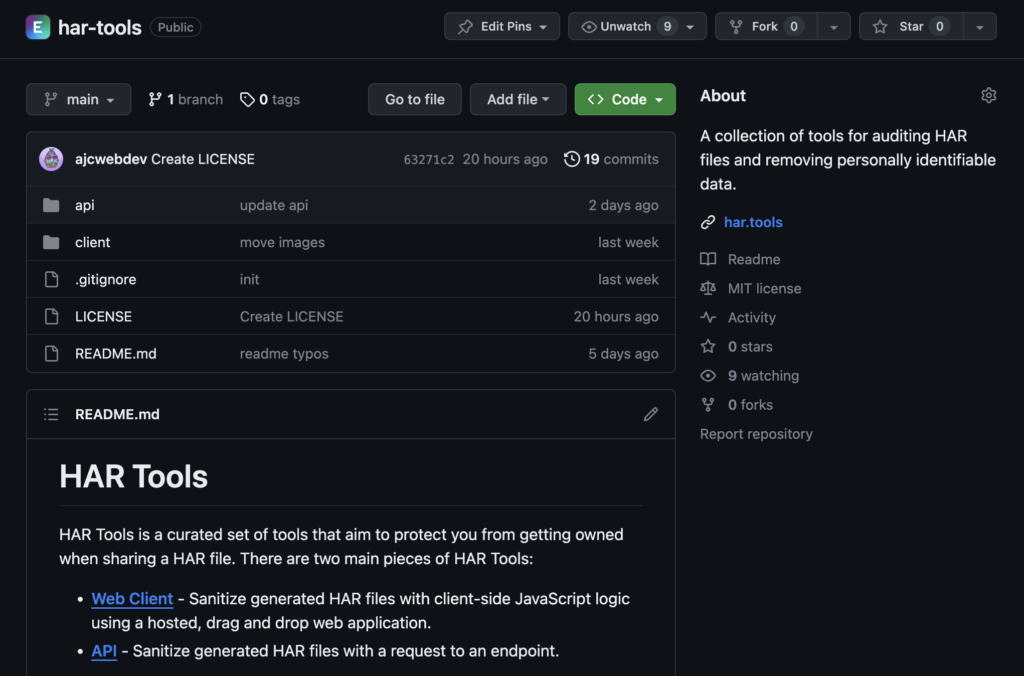What is a HAR File?
Benefits and Risks of HTTP Archive File Explained
Discover HAR files, their web performance insights, and secure handling practices to mitigate potential risks. Explore in our guide.
Contents
Related Pages
Welcome to our Learning Center page on HAR files! HAR, or HTTP Archive, is a file format used for recording web browser interactions and analyzing web page performance. In this article, we’ll review what HAR files are, their significance, potential security risks, and how they can be a valuable tool for web developers and performance analysts.
HAR (HTTP Archive) files play a crucial role in web development, as well as how it can be used to diagnose issues and optimize web performance.
What is a HAR File?
A HAR file, or HTTP Archive format file, is a JSON-formatted log of a web browser’s interactions with a site. It records all the requests sent and responses received, the time it took to load resources (like HTML, CSS, JavaScript files, and images), and details about headers, body contents, and server endpoints. This information is crucial for understanding web performance and identifying issues.
How Are They Generated
HTTP Archive files are generated by web browsers’ developer tools. Most modern browsers, such as Chrome, Firefox, and Safari, allow developers to export these files from their network monitoring tools. These files provide a snapshot of the browser’s activity, capturing detailed information about each web request and response.
The Importance of HAR Files in Web Development
Performance Analysis: They are instrumental in analyzing the performance of web applications. They help identify slow-loading resources, bottlenecks in network requests, and overall page load times.
Debugging: Developers use these files to debug issues in web applications. By examining the sequence of network requests and responses, it’s easier to pinpoint where issues are occurring.
Optimizing Resource Loading: Analyzing HAR files can lead to better strategies for resource loading, such as optimizing file sizes, implementing caching, or modifying the order of resource loading.
Security Assessments: They can also be used to review security headers and cookies used by the website, contributing to web application security assessments.
Analyzing HAR Files
To analyze a HAR file, you can use various tools available online, or you can manually inspect the file if you’re comfortable with JSON format. These analyses can reveal insights into how to improve website performance and user experience.
Potential Security Risks for Using HAR Files
While HAR files are incredibly useful, it’s important to handle them with care, as they can contain sensitive information like personal data, security tokens, or other private details.
What Could an Attacker do with an Unsanitized HAR file?
The short answer is a lot! A few of the potential risks associated with unauthorized access include:
- Session Hijacking: If the the file contains session tokens or sensitive cookies, a malicious actor could use this information to hijack a user’s session, gaining unauthorized access to their account.
- Data Exposure: Personal information, passwords, or other sensitive data exchanged between the client and server may be exposed, providing valuable information for identity theft or other malicious activities.
- Reconnaissance: The detailed information in a HTTP Archive file can be used for reconnaissance purposes, helping attackers understand the structure and vulnerabilities of a web application. This information may aid in planning more targeted attacks, XSS attacks or other forms for injection attacks.
- Privacy Exposure: HAR files may capture a user’s browsing behavior, including visited URLs. In the wrong hands, this information could be used for privacy violations or targeted phishing attacks.
If a bad actor were able to get their hands on a file generated by a website administrator or security personnel, they could potentially wreak havoc with your site or app. Through a successful session hijack, an attacker with admin privileges could turn down rate limiting to make a site more susceptible to DDoS attacks, modify bot management settings to block legitimate bots like Google’s and hurt SEO (and revenue), or even delete your website. There are many negative possibilities, but there are also steps you can take to lower your risk.
Mitigating the Risks – Edgio HAR File Sanitizer Tool
Edgio has built a Har file sanitizer tool to help remove potentially sensitive data from HAR files. If you’re going to send one of these files to someone (you’re having an issue with a site or app), or if you plan to receive them (you run a support team), Edgio has built a HAR sanitizer to remove all sensitive information from HAR files
Continuous Improvement
HTTP Archive files are a valuable tool for web developers and performance analysts. They provide a wealth of data that can be used to optimize website performance, debug issues, and enhance user experience.
The inherent risks associated with HAR files underscore the importance of meticulous sanitization and prudent usage. By taking proactive measures to remove sensitive data and adopting best practices, individuals and organizations can effectively mitigate security vulnerabilities and safeguard their digital assets.
Have Questions?
We understand that this is a lot to take in. If you have any questions or need further clarification, feel free to reach out. Our team is here to ensure that you have all the knowledge and tools you need for your online success. Click here to talk to an expert.
Trending Topics

Latest Cyber Security Threats 2023
